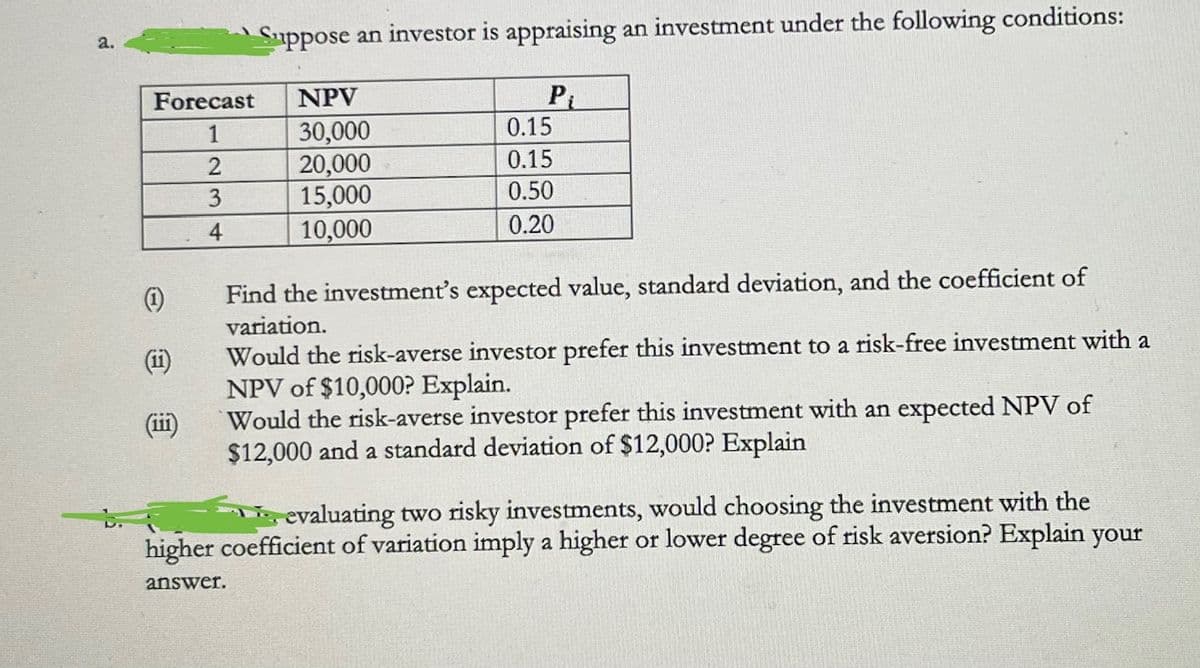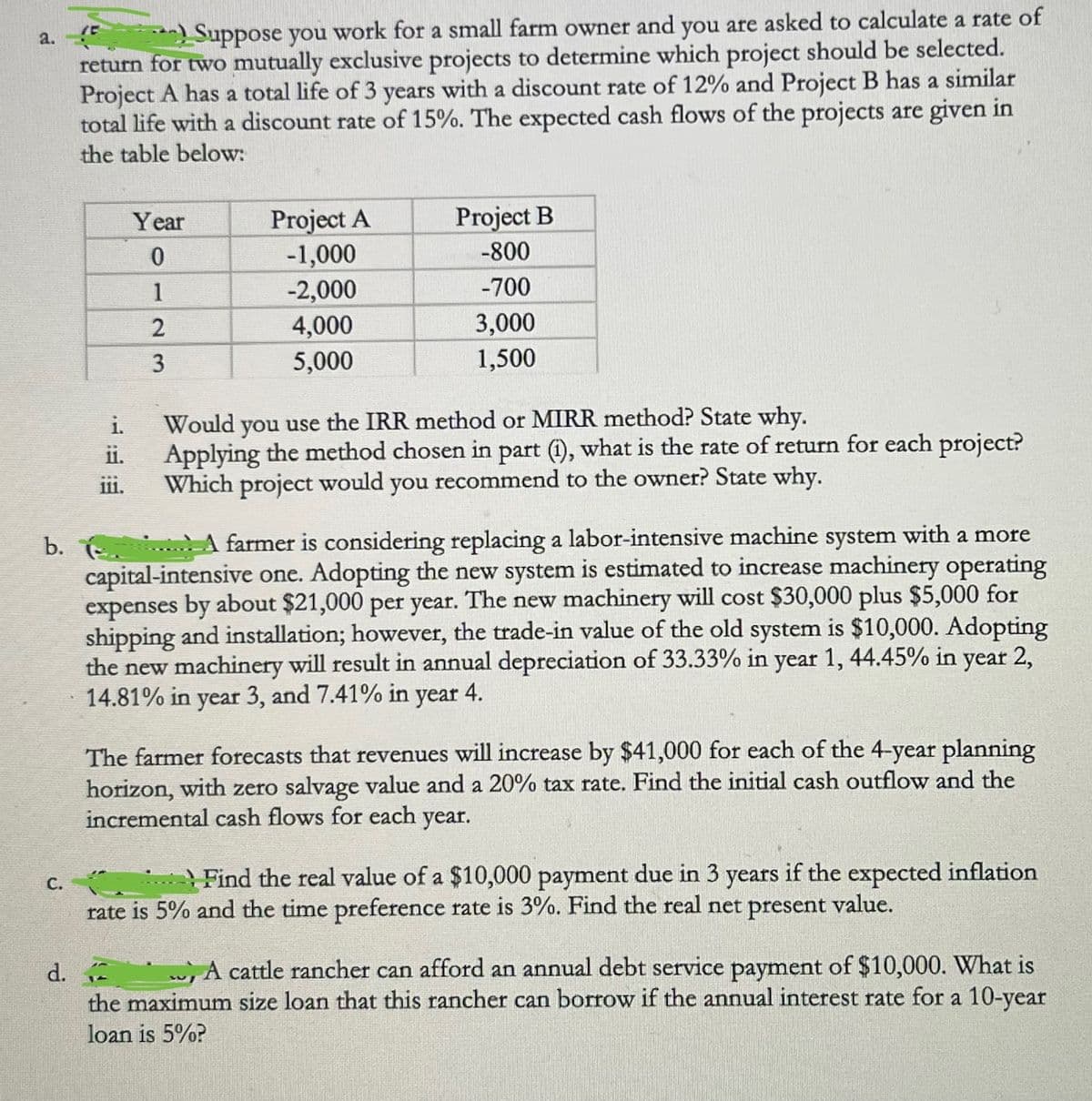Suppose an investor is appraising an investment under the following conditions: a. Pi 0.15 Forecast NPV 30,000 20,000 15,000 10,000 1 2 0.15 3 0.50 4 0.20 Find the investment's expected value, standard deviation, and the coefficient of variation. Would the risk-averse investor prefer this investment to a risk-free investment with a NPV of $10,000? Explain. Would the risk-averse investor prefer this investment with an expected NPV of $12,000 and a standard deviation of $12,000? Explain (1i) (画
Suppose an investor is appraising an investment under the following conditions: a. Pi 0.15 Forecast NPV 30,000 20,000 15,000 10,000 1 2 0.15 3 0.50 4 0.20 Find the investment's expected value, standard deviation, and the coefficient of variation. Would the risk-averse investor prefer this investment to a risk-free investment with a NPV of $10,000? Explain. Would the risk-averse investor prefer this investment with an expected NPV of $12,000 and a standard deviation of $12,000? Explain (1i) (画
Intermediate Financial Management (MindTap Course List)
13th Edition
ISBN:9781337395083
Author:Eugene F. Brigham, Phillip R. Daves
Publisher:Eugene F. Brigham, Phillip R. Daves
Chapter12: Capital Budgeting: Decision Criteria
Section: Chapter Questions
Problem 11MC: In an unrelated analysis, you have the opportunity to choose between the following two mutually...
Related questions
Question

Transcribed Image Text:Suppose an investor is appraising an investment under the following conditions:
a.
Forecast
NPV
Pi
0.15
30,000
20,000
15,000
10,000
1
0.15
3
0.50
4
0.20
Find the investment's expected value, standard deviation, and the coefficient of
variation.
Would the risk-averse investor prefer this investment to a risk-free investment with a
NPV of $10,000? Explain.
Would the risk-averse investor prefer this investment with an expected NPV of
$12,000 and a standard deviation of $12,000? Explain
(ii)
(iii)
evaluating two risky investments, would choosing the investment with the
higher coefficient of variation imply a higher or lower degree of risk aversion? Explain your
answer.

Transcribed Image Text:a.
return for two mutually exclusive projects to determine which project should be selected.
Project A has a total life of 3 years with a discount rate of 12% and Project B has a similar
total life with a discount rate of 15%. The expected cash flows of the projects are given in
the table below:
Suppose you work for a small farm owner and you are asked to calculate a rate of
Project A
-1,000
Year
Project B
-800
1
-2,000
-700
3,000
4,000
5,000
2
3
1,500
Would you use the IRR method or MIRR method? State why.
Applying the method chosen in part (1), what is the rate of return for each project?
Which project would you recommend to the owner? State why.
i.
ii.
ii.
b. A farmer is considering replacing a labor-intensive machine system with a more
capital-intensive one. Adopting the new system is estimated to increase machinery operating
expenses by about $21,000 per year. The new machinery will cost $30,000 plus $5,000 for
shipping and installation; however, the trade-in value of the old system is $10,000. Adopting
the new machinery will result in annual depreciation of 33.33% in year 1, 44.45% in year 2,
14.81% in year 3, and 7.41% in year 4.
The farmer forecasts that revenues will increase by $41,000 for each of the 4-year planning
horizon, with zero salvage value and a 20% tax rate. Find the initial cash outflow and the
incremental cash flows for each year.
Find the real value of a $10,000 payment due in 3 years if the expected inflation
C. .
rate is 5% and the time preference rate is 3%. Find the real net present value.
d. A cattle rancher can afford an annual debt service payment of $10,000. What is
the maximum size loan that this rancher can borrow if the annual interest rate for a 10-year
loan is 5%?
Expert Solution
This question has been solved!
Explore an expertly crafted, step-by-step solution for a thorough understanding of key concepts.
This is a popular solution!
Trending now
This is a popular solution!
Step by step
Solved in 8 steps

Knowledge Booster
Learn more about
Need a deep-dive on the concept behind this application? Look no further. Learn more about this topic, finance and related others by exploring similar questions and additional content below.Recommended textbooks for you

Intermediate Financial Management (MindTap Course…
Finance
ISBN:
9781337395083
Author:
Eugene F. Brigham, Phillip R. Daves
Publisher:
Cengage Learning


Financial And Managerial Accounting
Accounting
ISBN:
9781337902663
Author:
WARREN, Carl S.
Publisher:
Cengage Learning,

Intermediate Financial Management (MindTap Course…
Finance
ISBN:
9781337395083
Author:
Eugene F. Brigham, Phillip R. Daves
Publisher:
Cengage Learning


Financial And Managerial Accounting
Accounting
ISBN:
9781337902663
Author:
WARREN, Carl S.
Publisher:
Cengage Learning,

Managerial Accounting
Accounting
ISBN:
9781337912020
Author:
Carl Warren, Ph.d. Cma William B. Tayler
Publisher:
South-Western College Pub

EBK CONTEMPORARY FINANCIAL MANAGEMENT
Finance
ISBN:
9781337514835
Author:
MOYER
Publisher:
CENGAGE LEARNING - CONSIGNMENT

Cornerstones of Cost Management (Cornerstones Ser…
Accounting
ISBN:
9781305970663
Author:
Don R. Hansen, Maryanne M. Mowen
Publisher:
Cengage Learning